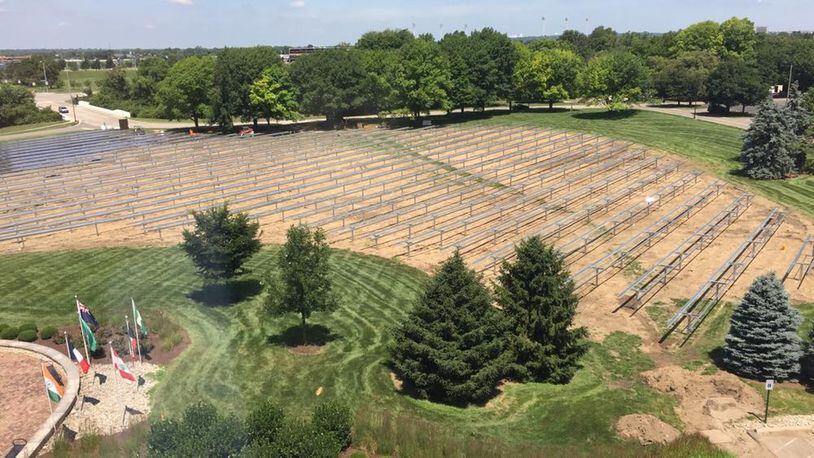Universities are spending too much money right now, Vedder said, and sustainability programs are often a prime example of this. Instead, they should be charging students less for tuition and fees, he said.
» RELATED: UD names leader of new cybersecurity and data intelligence center
“It’s a nice story but I think the cost of putting it in far exceeds minuscule savings,” Vedder said.
UD recently installed more than 4,000 solar panels outside its research institute, the school has a composting program already in place and is considering making UD Arena a “zero waste” facility once renovations are completed in 2019. Achieving a “zero waste” status means 90 percent of the products sold at the arena would be recyclable or compostable, said Steve Kendig, UD executive director of energy utilization and environmental sustainability.
While businesses such as Starbucks are starting to eliminate plastic straws at their stores, UD has been using compostable straws since 2009, according to the university.
“All this stuff sounds easy, composting and everything, but once you start getting into it there’s a lot involved with it so it takes time to get these programs developed,” Kendig said.
It will take years before UD sees a savings from its new solar panels which will provide around 10 percent of the power used at Fitz Hall and Curran Place and around 2 percent of the power for campus.
Solar panels have been an attractive sustainability initiative for colleges.
Cedarville University in 2016 reported that its solar panels —one of the largest array of panels at any of Ohio’s universities —produced around 13 percent of the school’s electricity. Antioch College in Yellow Springs also has a “solar farm” and panels atop some of its buildings.
» RELATED: Wright State president not given raise, bonus due to budget issues
UD is already seeing a return on investment from the $1 million it placed in its green revolving fund two years ago.
With lighting upgrades, UD is saving $400,000 annually and received a $500,000 rebate from Dayton Power & Light, according to the university. Andy Horner, UD’s vice president for finance referenced the savings to push back on the idea that the university’s green initiatives are more of a public relations victory than a financial one.
“The University already is seeing positive returns on our green investments, which allow us to accelerate additional investments in energy-saving improvements to campus operations and hold down costs for students plus foster sustainability-related research and hands-on learning opportunities for students. We expect, over time, the cost savings will be significant and will enable us to continue to invest in ideas that save money and protect the environment.,” Horner said via email.
UD isn’t alone in its sustainability efforts. Virtually every area university boasts about its savings from green initiatives and employs people dedicated to running such programs.
A 2012 initiative at Wright State University slashed energy costs in the school’s labs by 43 percent, according to the school. Miami University has a goal of reducing its carbon emissions by 20 percent by 2020 and a Wittenberg University task force has addressed issues of sustainability, recycling and climate change on campus since 2009, according to each school.
» RELATED: UD Arena to become a ‘zero waste’ facility after renovations
The benefits aren’t just financial either as students often get hands on experience through UD’s green programs, both Kendig and Horner said. Students will now be able to experiment with some of the solar panels recently installed at Curran Place and they’ll also be involved in a possible on-campus composting plan that’s being developed, Kendig said.
While that experience may be valuable, sustainability programs are going outside the scope of what universities are meant to do, Vedder said. It means universities are spending money on things that should stay in their “periphery,” Vedder said.
“Universities are engaging in all sorts of activities which are not job one. Job one is educating and maybe research,” Vedder said. “We’re getting into too many other things that are not essential.”
FIVE FAST READS
• Bill to make it easier for military spouses to continue careers in Ohio
• New furniture store to open location at two Dayton-area malls
• Wright State president not given raise, bonus due to budget issues
• Good Samaritan Hospital officially closes down for good
• State suing Dayton company for ‘shoddy work
THANKS FOR READING
The Dayton Daily News is committed to bringing you independent, in-depth local stories. Help support our journalism by signing up for a print or digital subscription.
By the numbers
4,000+: Number of solar panels UD just installed.
2 percent: Power solar panels will provide to UD campus.
$400,000: Amount UD saves annually from lighting upgrades.
90 percent: Waste that may be recyclable/ compostable at UD Arena after renovations
9 years: Time UD dining facilities have been using compostable straws.
About the Author
